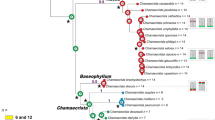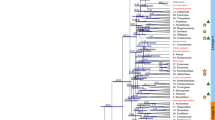Abstract
Brassicales comprise 17 families, c. 400 genera and more than 4600 species. Despite the mustard family (crucifers, Brassicaceae) continuing to be the subject of intensive research, the remaining 16 families are largely under studied. Here I summarize the available data on chromosome number and genome size variation across Brassicales in the context of a robust phylogenetic framework. This analysis has revealed extensive knowledge gaps in karyological data for non-crucifer and species-rich families in particular (i.e., Capparaceae, Cleomaceae, Resedaceae and Tropaeolaceae). A parsimonious interpretation of the combined chromosomal and phylogenetic data set suggests that the ancestral pre-Brassicales genome had 9 or 14 chromosome pairs, later multiplied by the At-β (beta) whole-genome duplication (WGD) to n = 18 or 28. This WGD was followed by post-polyploid diploidization marked by diversification to 12 or 13 families and independent decreases in chromosome numbers. Family-specific WGDs are proposed to precede the diversification of Capparaceae, Resedaceae and Tropaeolaceae.


Similar content being viewed by others
References
Arabidopsis Genome Initiative (2000) Analysis of the genome sequence of the flowering plant Arabidopsis thaliana. Nature 408:796–815. https://doi.org/10.1038/35048692
Argout X, Salse J, Aury JM, Guiltinan MJ, Droc G, Gouzy J, Allegre M, Chaparro C, Legavre T, Maximova SN, Abrouk M, Murat F, Fouet O, Poulain J, Ruiz M, Roguet Y, Rodier-Goud M, Barbosa-Neto JF, Sabot F, Kudrna D, Ammiraju JS, Schuster SC, Carlson JE, Sallet E, Schiex T, Dievart A, Kramer M, Gelley L, Shi Z, Bérard A, Viot C, Boccara M, Risterucci AM, Guignon V, Sabau X, Axtell MJ, Ma Z, Zhang Y, Brown S, Bourge M, Golser W, Song X, Clement D, Rivallan R, Tahi M, Akaza JM, Pitollat B, Gramacho K, D’Hont A, Brunel D, Infante D, Kebe I, Costet P, Wing R, McCombie WR, Guiderdoni E, Quetier F, Panaud O, Wincker P, Bocs S, Lanaud C (2010) The genome of Theobroma cacao. Nat Genet 43:101–108. https://doi.org/10.1038/ng.736
Barker MS, Vogel H, Schranz ME (2009) Paleopolyploidy in the Brassicales: analyses of the Cleome transcriptome elucidate the history of genome duplications in Arabidopsis and other Brassicales. Genome Biol Evol 1:391–399. https://doi.org/10.1093/gbe/evp040
Bennett MD, Leitch IJ (2012) Angiosperm DNA C-values database (release 8.0, Dec. 2012). Available at: http://www.kew.org/cvalues/
Bowers JE, Chapman BA, Rong J, Paterson AH (2003) Unravelling angiosperm genome evolution by phylogenetic analysis of chromosomal duplication events. Nature 422(6930):433–438. https://doi.org/10.1038/nature01521
Cardinal-McTeague WM, Sytsma KJ, Hall JC (2016) Biogeography and diversification of Brassicales: a 103 million year tale. Molec Phylogen Evol 99:204–224. https://doi.org/10.1016/j.ympev.2016.02.021
Cheng S, van den Bergh E, Zeng P, Zhong X, Xu J, Liu X, Hofberger J, de Bruijn S, Bhide AS, Kuelahoglu C, Bian C, Chen J, Fan G, Kaufmann K, Hall JC, Becker A, Bräutigam A, Weber AP, Shi C, Zheng Z, Li W, Lv M, Tao Y, Wang J, Zou H, Quan Z, Hibberd JM, Zhang G, Zhu XG, Xu X, Schranz ME (2013) The Tarenaya hassleriana genome provides insight into reproductive trait and genome evolution of crucifers. Pl Cell 25:2813–2830. https://doi.org/10.1105/tpc.113.113480
Christenhusz MJ, Byng JW (2016) The number of known plants species in the world and its annual increase. Phytotaxa 261:201–217. https://doi.org/10.11646/phytotaxa.261.3.1
Cremonini R (2005) Low chromosome number angiosperms. Caryologia 58:403–409. https://doi.org/10.1080/00087114.2005.10589480
Edger PP, Hall JC, Harkess A, Tang M, Coombs J, Mohammadin S, Schranz ME, Xiong Z, Leebens-Mack J, Meyers BC, Systma KJ, Koch M, Al-Shehbaz IA, Pires JC (2018) Brassicales phylogeny inferred from 72 plastid genes: a reanalysis of the phylogenetic localization of two paleopolyploid events and origin of novel chemical defenses. Amer J Bot 105. https://doi.org/10.1002/ajb2.1040
Gandolfo MA, Dibbern MC, Romero EJ (1988) Akania patagonica n. sp. and additional material on Akania americana Romero & Hickey (Akaniaceae), from Paleocene sediments of Patagonia. Bull Torrey Bot Club 115:83–88. https://doi.org/10.2307/2996138
Huang CH, Zhang C, Liu M, Hu Y, Gao T, Qi J, Ma H (2016) Multiple polyploidization events across Asteraceae with two nested events in the early history revealed by nuclear phylogenomics. Molec Biol Evol 33:2820–2835. https://doi.org/10.1093/molbev/msw157
Jaillon O, Aury JM, Noel B, Policriti A, Clepet C, Casagrande A, Choisne N, Aubourg S, Vitulo N, Jubin C, Vezzi A, Legeai F, Hugueney P, Dasilva C, Horner D, Mica E, Jublot D, Poulain J, Bruyère C, Billault A, Segurens B, Gouyvenoux M, Ugarte E, Cattonaro F, Anthouard V, Vico V, Del Fabbro C, Alaux M, Di Gaspero G, Dumas V, Felice N, Paillard S, Juman I, Moroldo M, Scalabrin S, Canaguier A, Le Clainche I, Malacrida G, Durand E, Pesole G, Laucou V, Chatelet P, Merdinoglu D, Delledonne M, Pezzotti M, Lecharny A, Scarpelli C, Artiguenave F, Pè ME, Valle G, Morgante M, Caboche M, Adam-Blondon AF, Weissenbach J, Quétier F, Wincker P, French-Italian Public Consortium for Grapevine Genome Characterization (2007) The grapevine genome sequence suggests ancestral hexaploidization in major angiosperm phyla. Nature 449:463–467. https://doi.org/10.1038/nature06148
Kiefer M, Schmickl R, German DA, Lysak M, Al-Shehbaz IA, Franzke A, Mummenhoff K, Stamatakis A, Koch MA (2014) BrassiBase: introduction to a novel database on Brassicaceae evolution. Pl Cell Physiol 55:e3. https://doi.org/10.1093/pcp/pct158
Koch MA, German DA, Kiefer M, Franzke A (2018) Database taxonomics as key to modern plant biology. Trends Pl Sci 23:4–6. https://doi.org/10.1016/j.tplants.2017.10.005
Maere S, De Bodt S, Raes J, Casneuf T, Van Montagu M, Kuiper M, Van de Peer Y (2005) Modeling gene and genome duplications in eukaryotes. Proc Natl Acad Sci USA 102:5454–5459. https://doi.org/10.1073/pnas.0501102102
Mandáková T, Lysak MA (2018) Post-polyploid diploidization and diversification through dysploid changes. Curr Opin Pl Biol 42:55–65. https://doi.org/10.1016/j.pbi.2018.03.001
Mandáková T, Li Z, Barker MS, Lysak MA (2017) Diverse genome organization following 13 independent mesopolyploid events in Brassicaceae contrasts with convergent patterns of gene retention. Pl J 91:3–21. https://doi.org/10.1111/tpj.13553
Ming R, Hou S, Feng Y, Yu Q, Dionne-Laporte A, Saw JH, Senin P, Wang W, Ly BV, Lewis KL, Salzberg SL, Feng L, Jones MR, Skelton RL, Murray JE, Chen C, Qian W, Shen J, Du P, Eustice M, Tong E, Tang H, Lyons E, Paull RE, Michael TP, Wall K, Rice DW, Albert H, Wang ML, Zhu YJ, Schatz M, Nagarajan N, Acob RA, Guan P, Blas A, Wai CM, Ackerman CM, Ren Y, Liu C, Wang J, Wang J, Na JK, Shakirov EV, Haas B, Thimmapuram J, Nelson D, Wang X, Bowers JE, Gschwend AR, Delcher AL, Singh R, Suzuki JY, Tripathi S, Neupane K, Wei H, Irikura B, Paidi M, Jiang N, Zhang W, Presting G, Windsor A, Navajas-Pérez R, Torres MJ, Feltus FA, Porter B, Li Y, Burroughs AM, Luo MC, Liu L, Christopher DA, Mount SM, Moore PH, Sugimura T, Jiang J, Schuler MA, Friedman V, Mitchell-Olds T, Shippen DE, dePamphilis CW, Palmer JD, Freeling M, Paterson AH, Gonsalves D, Wang L, Alam M (2008) The draft genome of the transgenic tropical fruit tree papaya (Carica papaya Linnaeus). Nature 452:991–996. https://doi.org/10.1038/nature06856
Patchell MJ, Roalson EH, Hall JC (2014) Resolved phylogeny of Cleomaceae based on all three genomes. Taxon 63:315–328. https://doi.org/10.12705/632.17
Rice A, Glick L, Abadi S, Einhorn M, Kopelman NM, Salman-Minkov A, Mayzel J, Chay O, Mayrose I (2015) The Chromosome Counts Database (CCDB)—a community resource of plant chromosome numbers. New Phytol 206:19–26. https://doi.org/10.1111/nph.13191
Rockinger A, Sousa A, Carvalho FA, Renner SS (2016) Chromosome number reduction in the sister clade of Carica papaya with concomitant genome size doubling. Amer J Bot 103:1082–1088. https://doi.org/10.3732/ajb.1600134
Salse J (2016) Ancestors of modern plant crops. Curr Opin Pl Biol 30:134–142. https://doi.org/10.1016/j.pbi.2016.02.005
Schranz ME, Mitchell-Olds T (2006) Independent ancient polyploidy events in the sister families Brassicaceae and Cleomaceae. Pl Cell 18:1152–1165. https://doi.org/10.1105/tpc.106.041111
Schranz ME, Mohammadin S, Edger PP (2012) Ancient whole genome duplications, novelty and diversification: the WGD Radiation Lag-Time Model. Curr Opin Pl Biol 15:147–153. https://doi.org/10.1016/j.pbi.2012.03.011
Stevens PF (2001 onwards) Angiosperm phylogeny website. Version 14, July 2017 [and more or less continuously updated since]. Available at: http://www.mobot.org/MOBOT/research/APweb/
Tian Y, Zeng Y, Zhang J, Yang C, Yan L, Wang X, Shi C, Xie J, Dai T, Peng L, Zeng Huan Y, Xu A, Huang Y, Zhang J, Ma X, Dong Y, Hao S, Sheng J (2015) High quality reference genome of drumstick tree (Moringa oleifera Lam.), a potential perennial crop. Sci China Life Sci 58:627–638. https://doi.org/10.1007/s11427-015-4872-x
Warwick S, Al-Shehbaz IA (2006) Brassicaceae: chromosome number index and database on CD-Rom. Pl Syst Evol 259:237–248. https://doi.org/10.1007/s00606-006-0421-1
Acknowledgements
I thank Patrick P. Edger for discussing the phylogenetic placement of the At-β event and Terezie Mandáková for her help with the chromosome images presented in Fig. 2. This work was supported by a research grant from the Czech Science Foundation (Grant No. P501/12/G090) and the CEITEC 2020 Project (Grant No. LQ1601).
Author information
Authors and Affiliations
Corresponding author
Ethics declarations
Conflict of interest
The authors declare that they have no conflict of interest.
Human and animal rights
This article does not contain any studies with human participants or animals performed by any of the authors.
Additional information
Handling editor: Karol Marhold.
Electronic supplementary material
Below is the link to the electronic supplementary material.
Information on Electronic Supplementary Material
Information on Electronic Supplementary Material
Online Resource 1. List of chromosome numbers and genome sizes of Brassicales taxa.
Rights and permissions
About this article
Cite this article
Lysak, M.A. Brassicales: an update on chromosomal evolution and ancient polyploidy. Plant Syst Evol 304, 757–762 (2018). https://doi.org/10.1007/s00606-018-1507-2
Received:
Accepted:
Published:
Issue Date:
DOI: https://doi.org/10.1007/s00606-018-1507-2




